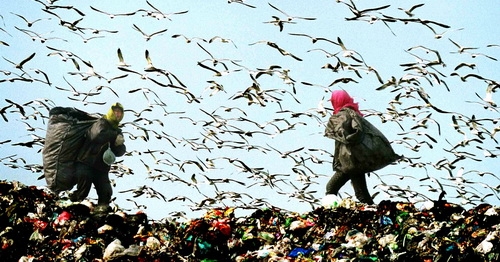


By Zhong Ang (种昂)
Nation, page 9
Issue 541
Oct 24, 2011
Translated by Laura Lin
Original Article: [Chinese]
The innermost bay of the Yellow Sea on the northeastern coast of China, the semi-enclosed Bohai Gulf, used to be known as the country's "fish basket," once accounting for 40 percent of China's fishing output. Now, in ecological terms, it is dying a rapid death that is taking place in tandmen with the region's breakneck economic development.
According to the "Tianjin Marine Environmental Quality Report," (天津市海洋环境质量公报) none of the three coastal water monitoring sites near Tianjin, the major city of the area, meets the water requirement standard for marine life protection and safe human use. China's State Oceanic Administration official was even more blunt: "Bohai has basically lost its function as a fishing ground."
With significant oil and gas reserves in the adjacent region, Tianjin was chosen by Chinese authorities in 2006 as the third national pilot area for development, after the Shenzhen Special Economic Zone in Guangdong, and the Shanghai Pudong New Area.
With Bohai's emerging economy, water quality has plummeted. While the GDP of the area rose by nearly 40 percent between 2005 and 2010, the polluted area has also risen from 15 to 22 percent of this inland sea zone that totals 77,000 square kilometers, with an average depth of less than 20 meters. The natural rate for water recycling is some 60 years (some experts say it's as much as 200 years).
Along parts of Bohai's shoreline, including Jinzhou Bay, zinc levels have been detected as high as 2,000 times what's normally considered safe, while lead readings were 300 percent above acceptable levels.
Among the industrial sectors in full swing, local governments tend to favor the heavy chemical industry, as it makes larger contributions to GDP growth and because of the associted industries, creates more jobs.
The pollution related to the petrochemical industry, though proportionally small, will cause the most severe damage to the region's marine ecosystem over the long term since the ocean itself cannot break down heavy metals like lead and cadmium.
This year alone, there have been a series of serious oil spills from the oil platforms that are owned by two major petrochemical companies operating in the region - China National Offshore Oil Corporation (中国海洋石油总公司) and its joint venture partner, America's ConocoPhillips.
Currently, 80 percent of Bohai's pollution comes from the land surrounding the gulf, and is piped into the gulf by three waterways including the Yellow River.
Sources include fertilizer and pesticides used in agriculture, industrial waste and urban sewage discharge.
The effects are devastating and are also exacerbated by large land reclamation projects that destroy vast swathes of wetlands and tidal flats, which had once served as nature's purification organs, helping to filter and decompose a lot of the polluting elements.
The coastline region traditionally has had an economy based on fishing, and countless residents risk seeing their livelihoods quickly evaporate.
News in English via World Crunch (link)

